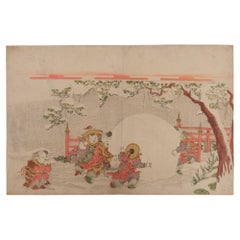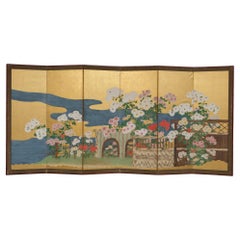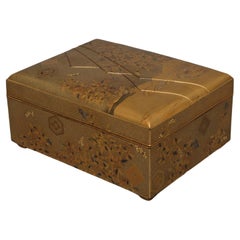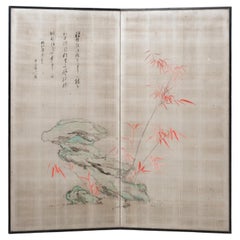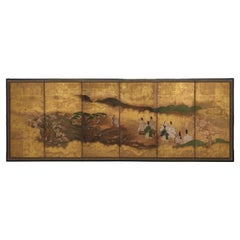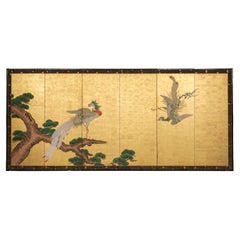Japanese Antique Store
to
16
13
8
7
4
3
2
1
1
1
1
1
1
1
1
1
1
1
Original Japanese Woodblock Print of Playing Children by Katsukawa Shunsen 勝川春扇
By Katsukawa Shunsen
Located in Amsterdam, NL
Original Japanese woodblock print by Katsukawa Shunsen (Shunko II) (1762- circa 1830): five karako (Chinese boys) in traditional garments at play in a snow covered garden, making an ...
Category
Antique 1810s Japanese Prints
Materials
Paper
Large Japanese 6-panel byôbu 屏風 (folding screen) with chrysanthemum garden
Located in Amsterdam, NL
A very colourful and captivating large six-panel byôbu (folding screen) with a refined continuous painting of a luscious flower garden filled with many different types of chrysanthemums (kiku), next to a winding river.
This multi-coloured painting is set on a shiny gold-leaf background, and the chrysanthemum flowers are painted by using shell paste (gofun) in low relief.
Several clutches with a great variety of chrysanthemum flowers are in full bloom and they each show their unique form and colour. Varying from white, red, yellow and pink. The flowers bloom all around and on different kinds of bamboo fences and trellises.
In Japan chrysanthemums are believed to represent happiness, love, longevity and joy.
The panels are surrounded by two silk borders, a thin black one, and a wide brown one. The screen is protected by a black and red negoro’nuri...
Category
Antique Late 19th Century Japanese Paintings and Screens
Materials
Gold Leaf
Exceptional Japanese Gold Lacquer Tebako 手箱 'Box for Personal Accessories'
Located in Amsterdam, NL
Exceptional Japanese rectangular gold lacquer tebako (box for personal accessories) with a slightly domed well-fitted lid and raised by four low bracket feet. The lid finely carved with pointed shapes as if it is covered by folded papers.
On top of this embossed surface it is decorated with gold and silver hiramaki-e (low-relief design) and takamaki-e (high-relief design) depicting a wild winding river landscape with along the waterfront...
Category
Antique 19th Century Japanese Lacquer
Materials
Giltwood, Lacquer
Large Japanese 2-Panel Byôbu 屏風 'Room Divider' with Painting of Bamboo & a Poem
Located in Amsterdam, NL
Beautiful, large two-panel byôbu (room divider) with a serene painting of red-leaved bamboo and rocks on an oxidized silver leaf background. Silver leaf continuously undergoes the process of oxidation, which creates a beautiful aged patina.
On the left an inscription from a ‘Zekku’ poem by the Chinese poet Yang Zai (1271?1323), titled: Shan shang zhu (bamboo (painted) on a fan).
Translated as :
Why would people plant a lot of bamboos?
The shade of a single culm is also beautiful.
In the autumn night it rocks on the wind,
And the fresh sound echoes in my dream.
Dated: Shôwa, the year kôshin (1938). Signature unknown...
Category
Early 20th Century Japanese Paintings and Screens
Materials
Other, Silver Leaf
Mid-size 6-panel byôbu 屏風 with a scene from The Tale of Genji
Located in Amsterdam, NL
A refined medium-sized six-panel byôbu (folding screen) showcasing a classical autumn court scene from chapter 7 of The Tale of Genji (Genji Monogatari), titled Momiji no Ga (The Aut...
Category
Antique 17th Century Japanese Paintings and Screens
Materials
Metal, Gold Leaf
Tall 6-panel byôbu with phoenixes attributed to Kanô Isen’in Naganobu
By Kano Isen'in Naganobu
Located in Amsterdam, NL
An exquisite, tall six-panel byôbu (folding screen) featuring a painting attributed to Kanô Isen’in Naganobu (1775–1828) depicting a pair of phoenixes (hô’ô) and a section of a large...
Category
Antique Early 19th Century Japanese Paintings and Screens
Materials
Metal, Gold Leaf
Portable jû'bako 重箱 (tiered food container)
Located in Amsterdam, NL
A rare, high quality lacquered portable jû'bako (tiered food container/stacked picnic box) fitted with a removable vertical safety bar - housing a nice secret – decorated with a refi...
Category
Antique Late 19th Century Japanese Lacquer
Materials
Brass
Japanese lacquer suzuri’bako 硯箱 (writing box) with ‘Rinpa School’-style design
Located in Amsterdam, NL
Superb rectangular ‘Rinpa School’-style black lacquer suzuri’bako (writing box) with a slightly arched well-fitted overhanging cover with rounded corners.
The lid with a design of a gosho’guruma (ox-drawn carriage for Heian-era nobles) featuring golden hiramaki-e (low-relief lacquer design) and takamaki-e (high-relief lacquer design), inlays of lead and shiny mother-of-pearl (raden). The design continues along the sides.
The reverse of the lid decorated with two large curving pine trees (matsu) executed in the same way, but also with intricate dots of tiny pieces of inlaid blue mother-of-pearl along the golden trunk.
The interior shaped to hold various scholar’s accessories, including a partially gold lacquered inkstone (suzuri) and a bronze waterdropper (suiteki) shaped like a mythical minogame.
The interior inscribed ‘Hokkyô Kôrin zô’ (Made by Hokkyô Kôrin). Referring to the design being in style of the master Ogata Kôrin, but the actual lacquer artist is unknown. It is a homage to Kôrin by an artist that followed the school of Rinpa.
Including black lacquer wooden tomobako (tomobako).
The Rinpa School was a key part of the Edo period revival of indigenous Japanese artistic interests described by the term yamato-e. Paintings, textiles, ceramics, and lacquerwares were decorated by Rinpa artists with vibrant colours applied in a highly decorative and patterned manner. Favoured themes, which often contained evocative references to nature and the seasons, were drawn from Japanese literature, notably The Tale of Genji, The Tales of Ise...
Category
Antique 19th Century Japanese Lacquer
Materials
Brass, Lead
Japanese porcelain okimono 置物 of a sitting child, by Sakaida Kakiemon XII
By Sakaida Kakiemon Xii
Located in Amsterdam, NL
Exquisite white glazed porcelain figure (okimono) of a sitting child holding a spray of chrysanthemum flowers with cobalt blue glazed leaves in its hand, by Sakaida Kakiemon XII (1878–1963).
The milk white glaze is called nigoshide a type of technique which was not continued at the end of the Edo period, and is the famous rediscovery done by Sakaida Kakiemon XII in 1953.
The bottom signed ‘Kakiemon’.
Sakaida Kakiemon XII assumed the family title on the death of his father, Sakaida Kakiemon XI, in 1917. Earlier he had graduated from the Arita Apprentice School and then studied ceramics with his father. Initially he worked in the traditional Kakiemon style, echoing the work of his forbears in the 17th and 18th centuries. He began working with his own son in 1924, after the future Kakiemon XIII graduated from the Arita Industrial School. Together in 1953 they succeeded in recreating the classical Kakiemon technique for producing a nigoshide milky-white porcelain body. This technique was designated a national cultural treasure meriting preservation and protection by the Cultural Protection Committee in 1955. That same year he exhibited at the 2nd Japan Traditional Crafts Exhibition (Nihon Dento Kogei-ten) for the first time, winning a prize for his entry. In 1958, he exhibited at the World Exposition...
Category
20th Century Japanese Sculptures and Carvings
Materials
Porcelain
Japanese 'double gourd' lacquer suzuri’bako (writing box) by Hara Yôyûsai 原羊遊斎
By Hara Yôyûsai
Located in Amsterdam, NL
An uniquely double-gourd-shaped lacquer suzuri’bako (writing box) with a design of gourd leaves, by Hara Yôyûsai (1769-1845).
Covered with amber coloured l...
Category
Antique Early 19th Century Japanese Lacquer
Materials
Bronze
Japanese lacquer suzuri’bako 硯箱 (writing box) with shishi & Hotei design
Located in Amsterdam, NL
A captivating lacquer suzuri’bako (writing box) of rounded rectangular form depicting a pair of shishi (temple lions) and the lucky god Hotei 布袋 on a rôiro...
Category
Antique Early 19th Century Japanese Lacquer
Materials
Gold Leaf, Silver Leaf
Japanese Sado ishô dansu 衣装箪笥 (cabinet of drawers) with elaborate hardware
Located in Amsterdam, NL
Exceptional, rare and completely restored wooden Sado ishô dansu (cabinet of drawers) with elaborately decorated open work iron hardware, in two sections. Fully restored, cleaned and waxed.
The exterior is made of hinoki cypress wood. Only slightly varnished, giving it a tad warmer colour. This soft underground lets the refined hardware stand out even more.
The upper part consists of two large drawers. The lower part with two drawers of different size and a hinged door. The interior behind the door with three small drawers. All the drawers are very deep and have a lot of volume, for easy storage. They run very smoothly as well.
The cabinet has extensively decorated hardware. The corner pieces of the drawers with stylized pine trees. The large decorative lock plates each with their own unique design of different auspicious animals; a peacock, a phoenix, a crane and a minogame. The hinged door decorated with different attributes of the Seven Gods of Fortune...
Category
Antique Late 19th Century Japanese Furniture
Materials
Iron
Pair of Japanese hinagata byôbu 雛形屏風 (small folding screens) with flower carts
Located in Amsterdam, NL
An amazing pair of six-panel hinagata byôbu (doll festival folding screens) with a continuous painting on gold leaf showcasing flower carts (hana’guruma) at the edge of a winding river.
Both laden with a large bamboo basket...
Category
Antique Early 19th Century Japanese Paintings and Screens
Materials
Gold Leaf
Japanese Edo-period gosho’ningyô 御所人形 (palace doll) of plump, seated child
Located in Amsterdam, NL
A charming gosho’ningyô (palace doll) of plump, seated child with a brilliant white skin and a small delicately elegant face, reminiscent of a young noble. The doll is playfully rais...
Category
Antique Early 19th Century Japanese Antiquities
Materials
Paste, Silk, Paint
Japanese large granular deep blue stoneware vase by Andô Hironobu 安藤博允 (1940)
By Andô Hironobu
Located in Amsterdam, NL
Magnificent and large Japanese organically-shaped oval stoneware vase decorated with a granular deep blue colour (seirôsai), titled: ‘Ginga yô’ (far a...
Category
Late 20th Century Japanese Ceramics
Materials
Stoneware
Large Japanese Ovoid Porcelain Vase with Blue & White Landscape, by Shigan 芝岩
Located in Amsterdam, NL
Very large ovoid shaped porcelain vase with a beautiful blue and white mountainscape design accentuated by a low relief details. The top of the vase ends in an elegant small neck.
Y...
Category
20th Century Japanese Ceramics
Materials
Porcelain
Japanese lacquer tebako 手箱 (box for personal accessories) with book design
Located in Amsterdam, NL
Superb rectangular black lacquer tebako (box for personal accessories) with a slightly domed well-fitted lid.
The lid has a continuous soft-tone multicoloured hiramaki-e (low-relief...
Category
Early 20th Century Japanese Lacquer
Materials
Lacquer
Japanese lacquered 5-tiered jûbako 重箱 (picnic box) with banana leaf design
Located in Amsterdam, NL
Elegant lacquered tiered jûbako (picnic box) comprising five stackable tiers, two covers, and a raised tray. Each bearing an attractive deep chestnut brown ground and lacquered in ta...
Category
Early 20th Century Japanese Lacquer
Materials
Giltwood, Lacquer
Tall, Japanese lacquer byôbu 屏風 (folding screen) by Mitsuo Takana 高名光夫 (1956)
By Mitsuo Takana
Located in Amsterdam, NL
Refined, tall two-panel byôbu (folding screen) completely adorned with ‘Wajima Ryûsaku’ lacquer by the Nitten award winning artist Mitsuo Takana (1956).
Featuring five refined images inspired by woodblock prints from the famous series ‘Tôkaidô gojûsan tsugi’ (The fifty-three stations of the Tokaido road), like the 1st station Nihonbashi, the 10th station Hakone, and the 21st station Okabe.
The design is executed in hiramaki-e (low-relief lacquer design) in shades of gold, silver, heightened by some multi-coloured details. Set on a shiny black lacquer substrate.
Signed in red lacquer in the lower right corner.
Including original signed & sealed wooden tomobako (storage box). The front with an inscription about the contents as described above. The inside:
‘Friend of the Nitten Exhibition Takana Mitsuo’ - Seal: ‘Hikari’.
‘Lacquer artist Wajima Ryûsaku’ - Seal: ‘Ryûsaku’.
Mitsuo Takana was born 1956 in Wajima, Ishikawa prefecture. He won several awards during exhibitions like: Ishikawa Contemporary Art Exhibition, Japan Artisans' Association Exhibition and the well-known Nitten Exhibition.
Dimensions:
Height 57.48 in/146 cm, Total width 66.92 in/170 cm (2 x 33.46 in/85 cm), Depth 1.10 in/2.8 cm.
Weight 56.21 lb/25.5 kg.
Wajima lacquerware...
Category
Late 20th Century Japanese Paintings and Screens
Materials
Wood, Giltwood, Lacquer
Japanese round wooden cha'dansu 茶箪笥 (tea cabinet)
Located in Amsterdam, NL
A remarkable round cha'dansu (tea cabinet) crafted from a hollowed tree trunk, resting on an organically shaped three-root base.
The exterior showcases a striking natural texture, e...
Category
Early 20th Century Japanese Furniture
Materials
Wood
Pair of Japanese kakejiku 掛け軸 (hanging scrolls) depicting Niô guardians 仁王
Located in Amsterdam, NL
Pair of impressive, antique kakejiku (hanging scrolls) showcasing the awe-inspiring Niô guardians, also referred to as heavenly kings.
Each painting cap...
Category
Antique Early 18th Century Japanese Paintings and Screens
Materials
Brocade, Silk, Paint
Japanese Lacquer Suzuribako 硯箱 'Writing Box' by Hattori Toshio 服部俊夫 '1943'
By Hattori Toshio (Shunsho)
Located in Amsterdam, NL
A small Japanese black and gold lacquer suzuribako (writing box) with cartwheels in water, by the artist Hattori Toshio (1943).
Of rectangular form with rounded corners, bearing a lustrous rôiro ground throughout, the exterior sides of the box and exterior of the cover finely decorated in gold and little silver takamaki-e with cartwheels flowing in a dynamically executed body of water with many swirls
and gushes as well as scattered dew drops, the interior tray fitted with a rectangular ink stone and silver suiteki (waterdropper).
The underside signed ‘Toshi’.
With the original wooden tomobako with hakogaki reading Namikuruma makie suzuribako (The
writing box set, with a design of wheels in water), as well as a leaflet written in Japanese with the artist’s biography up to 1987.
Hattori Toshio (b. 1943), art name Hattori Shunsho, was first selected for the Nitten exhibition in Showa 38 (1963). Since then, he has exhibited more than twenty times at the Nitten and other exhibitions, winning numerous prestigious awards. In 1995,
he had an audience with Pope John Paul II and presented the Pope with a lacquer reading table. In 2004, he created the shelves for the guest room of the Kyoto State Guest House of the Government of Japan. He is a member of the Kyoto Crafts Artists Association, the Kyoto Lacquer...
Category
Late 20th Century Japanese Lacquer
Materials
Wood, Giltwood, Lacquer
Japanese Patinated Bronze Trumpet Vase by Kanaya Gorôsaburô XI 金谷五良三郎
By Kanaya Gorôsaburô XI 金谷五良三郎
Located in Amsterdam, NL
Elegant brown patinated bronze trumpet vase with gold and red sprinkled design. It has an impressive broad outward curved mouth decorated on both sides with the dots. Its slender bod...
Category
Early 20th Century Japanese Metalwork
Materials
Bronze
Japanese Kamakura-bori 鎌倉彫 solid wooden étagère table with lotus design
Located in Amsterdam, NL
Alluring, well-made Kamakura-bori (lit. Kamakura carved) solid wooden étagère table with elaborate carvings depicting a bed of lotus leaves and buds. The top surface with natural flo...
Category
Early 20th Century Japanese Furniture
Materials
Wood
Massive and exceptional Japanese bamboo hanakago 花籠 (ikebana flower basket)
Located in Amsterdam, NL
A massive and exceptional bamboo hanakago (ikebana flower basket). The unusual and modernist basket with a loop handle and showing fine wickerwork in thick strips of bamboo of a ligh...
Category
20th Century Japanese Decorative Baskets
Materials
Bamboo
Large Japanese 6-panel byôbu 屏風 (folding screen) with genre painting
Located in Amsterdam, NL
Fascinating large six-panel byôbu (folding screen) with a detailed genre painting on goldish silver leaf with different scenes of people at work in a rural mountain village during th...
Category
Early 20th Century Japanese Paintings and Screens
Materials
Silver Leaf
Pair of Japanese Carved Wooden Temple Ornaments 木鼻 'Kibana' Shaped like Baku 獏
Located in Amsterdam, NL
A lovely pair of very detailed carved wooden temple ornaments (kibana) in the shape of elephant-like mythical creatures known as ‘Baku’.
Baku are Japan...
Category
Antique Early 19th Century Japanese Sculptures and Carvings
Materials
Wood
Large Japanese patinated bronze footed water basin (suiban) by Studio Heiwa 平和堂
Located in Amsterdam, NL
Large and heavy Japanese light brown patinated bronze footed water basin (suiban) with a mottled golden motif. The bowl with stepped concave rings and a n...
Category
Early 20th Century Japanese Metalwork
Materials
Bronze
Japanese Ecru Lacquered Natsume 棗 'Tea Caddy' with Maki-E of Carriage Wheels
Located in Amsterdam, NL
Uncommon ecru lacquer tea caddy (natsume) with a nice golden hiramaki-e (low-relief design) of cart wheels submerged in a wild swirling stream.
The design ...
Category
20th Century Japanese Lacquer
Materials
Giltwood, Lacquer
Japanese Bronze Okimono of a 'Karasu Tengu' 鴉天狗 Holding Up a Flower Branch
Located in Amsterdam, NL
Very refined Japanese bronze figure of a ‘karasu tengu’ holding a candlestick.
Well cast as a tengu in half-human, half-bird form standing atop a pile of leaves on a rounded square ...
Category
Antique Late 19th Century Japanese Metalwork
Materials
Bronze
Japanese lacquer oblong storage box by Hiroshi Hayashi 林宏 (1967)
By Hiroshi Hayashi
Located in Amsterdam, NL
An exceptional, oblong lacquer 3-tiered storage box with cover, reminiscent of a bento box, by Hiroshi Hayashi (1967). Covered in shiny gold and black l...
Category
21st Century and Contemporary Japanese Lacquer
Materials
Silk, Wood, Lacquer
Unique & Large Japanese Oribe-ware Chair by Suzuki Gorô
By Goro Suzuki 1
Located in Amsterdam, NL
Important and rare Japanese irregular shaped ceramic Oribe-ware chair with various designs in orange, white and black colours by the famous Japanese ceramist Suzuki Gorô...
Category
Mid-20th Century Japanese Ceramics
Materials
Stoneware
